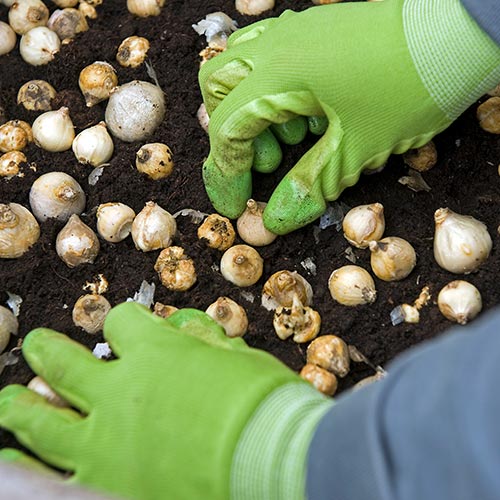How to Plant Flower Bulbs in the Fall
Flower bulbs that produce blooms in spring need to be planted in the fall or the very beginning of winter. Fall planted bulbs require cold temperatures in order to produce a flower bud. Additional information on when to plant bulbs in the fall can be found here.
Basics of Planting Bulbs in the Fall

- Flower bulbs require soil that drains well. They do not tolerate soil that does not drain well. Soil that holds water after a moderate rain will need to be amended prior to planting. Improve your soil by mixing compost into the soil. Adding Kelp Meal to the planting area will also help to improve soil quality and add nutrients. Well-draining soil is the most important factor in the health and survival of flower bulbs.
- The pointed end of the bulb should be facing the sky. For bulbs like tulips, daffodils, and hyacinths the pointed end is very noticeable. You may also notice remnants of dried roots, those should be touching the soil. Some bulbs don’t have a noticeably pointed end; in that case lay the bulb on its side and it will straighten itself out and reach for the light.
- Plant your fall bulbs at the proper planting depth. Proper planting depth is to plant 2-3 times the height of the bulb deep. If a bulb is 2” in height it should be planted 4-6” deep. Keep the packages your bulbs arrive in, as they have planting depth instructions printed on them. Planting deeper than recommended is always better for planting bulbs than planting too shallow.
- Spacing your bulbs will impact how they appear in your garden. Spacing also impacts their ability to return for several seasons. Our packages list recommended spacing; however, you may space the bulbs closer or further than our recommendations based on your desired outcome.
- For a full look and big color impact you may consider planting the bulbs closer together than the recommended spacing. As long as the bulbs aren’t touching, they can be planted fairly close together. Planting bulbs closer than the recommended spacing may mean they won’t come back strongly the following season. It could also mean that they will need to be divided sooner than they would if they were spaced further apart.
- Water your bulbs after the initial planting. Additional water in fall and winter is generally not necessary as the bulbs are dormant and do not require excess water at this time. Moisture from rain or snow is unavoidable and will not harm the bulbs as long as the soil drains well.
Steps for Planting Bulbs
- Purchase flower bulbs and wait for them to be delivered.
- Plant the flower bulbs at the appropriate planting time for your area based on seasonal temperatures.
- Dig a hole using a bulb auger, bulb planter or shovel to the proper planting depth.
- Place the bulbs in the planting area with the pointed end facing up. Lay the bulbs on the side if you aren’t sure which side is up.
- Fill in the planting location with the soil you dug out.
- Water the planting area lightly to help the soil settle.
- If deer, squirrels or other critters are a problem apply a repellent to the planting area.
- Sit back, relax and wait for spring blooms to arrive.